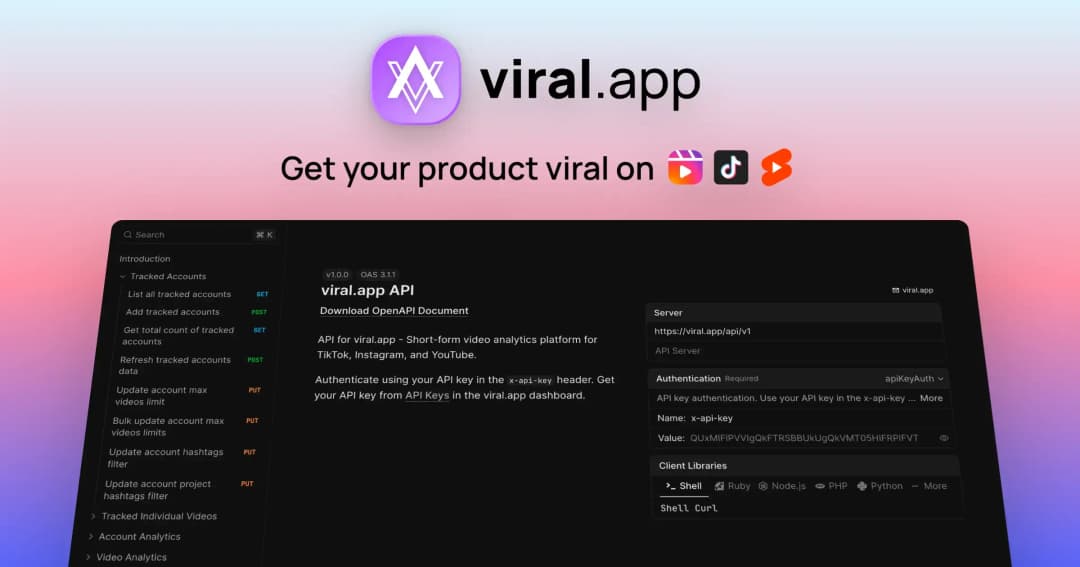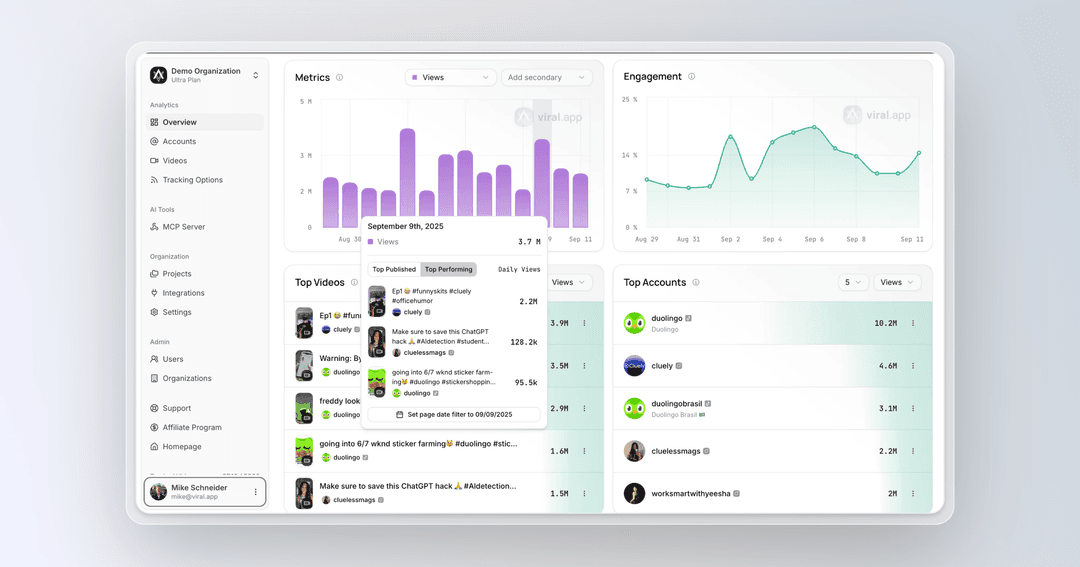Questions & Answers
We're here to help you get the most out of viral.app.
Go beyond one-off campaigns and build lasting, profitable brand partnerships.

Think of influencer relationship management (IRM) as nurturing a garden. You wouldn't just scatter seeds and hope for the best, would you? You'd carefully cultivate the soil, water the plants, and provide the right conditions for them to thrive.
Similarly, effective IRM isn't about one-off transactions. It's about building genuine, long-term relationships with influencers, much like tending to those growing plants. This approach is a world away from the old "transactional" model, where influencers were seen simply as platforms for paid advertisements.
This shift toward genuine partnership is reshaping the influencer marketing landscape. Instead of chasing vanity metrics like follower counts, brands are prioritizing authentic connections. The first step is to find the right content creators who truly align with your brand.
Imagine a sustainable clothing brand partnering with an influencer passionate about eco-conscious living. If the influencer truly believes in the brand's mission, their recommendation will carry far more weight than a simple paid promotion. That authenticity translates to greater trust and stronger engagement with their audience.
This evolution in influencer relationship management reflects a broader industry trend. We've seen a significant move towards more strategic and cost-effective partnerships in recent years.
For example, the average influencer marketing CPM (Cost Per Mille, or cost per 1,000 views) has dropped by a significant 53% year-over-year. This increased efficiency stems partly from brands prioritizing long-term influencer relationships, which yield a higher return on investment compared to short-term collaborations.
By 2027, the influencer marketing industry is projected to reach a staggering $47.8 billion, highlighting its growing importance in the world of digital marketing. Interestingly, while 57% of creators are raising their rates, 83% remain open to partnering with brands for free products, especially if those products align with their values or offer exceptional quality. This shows how influencer relationships are changing: creators are increasingly seeking meaningful partnerships, not just financial incentives. Discover more insights on the state of influencer marketing.
This focus on shared values and genuine connection benefits both brands and influencers. Brands gain access to engaged audiences and credible advocates. Influencers, in turn, get to collaborate with brands they genuinely admire.
This mutually beneficial arrangement creates a sense of shared success, laying the groundwork for sustainable growth and lasting impact. It encourages influencers to become true brand ambassadors, seamlessly integrating products and services into their content in an authentic way that resonates with their followers. This organic approach fosters deeper trust and ultimately drives more meaningful results for everyone involved.

In influencer marketing, the biggest names aren't always the best. Sure, celebrity endorsements still hold sway, but smart brands are increasingly turning to micro-influencers. These creators, with their smaller but highly engaged audiences, are changing the game of influencer relationship management. Think of it as a shift from a loudspeaker to a laser pointer: more focused, more precise.
So, why are micro-partnerships so effective? It's all about connection. Imagine a packed stadium concert versus an intimate coffee date. The stadium show reaches thousands, but the connection is impersonal. The coffee date? That's where real conversation happens, where trust is built.
Micro-influencers create these "coffee date" communities. Their followers share specific interests and values. This makes recommendations feel like friendly advice, not a sales pitch.
This authenticity translates to real results. Smaller, dedicated audiences are more likely to act on a micro-influencer's suggestion. This targeted approach often outperforms broad strategies that can get lost in the social media shuffle. Understanding platforms like LinkedIn is key for successful influencer relationship management, especially when crafting engaging content. For tips on creating compelling LinkedIn posts, check out this guide: Engaging LinkedIn Posts.
Finding the right micro-influencers is crucial. It's not just about follower count; it's about shared values. The goal is to find an authentic alignment, where the influencer truly connects with your brand and can genuinely represent your products to their community. Tools like viral.app can help automate this discovery process, finding creators who are a perfect fit for your app or brand.
Let's talk numbers. Micro-influencers often see higher engagement rates than their macro counterparts, making them very attractive for targeted campaigns. For example, some brands have reported earning $4.12 for every $1 spent on Instagram influencer campaigns. This speaks volumes about the potential ROI. Meanwhile, the overall engagement rate for Instagram influencers has dipped to about 1.59%, highlighting the importance of focusing on niche audiences over broad reach. Learn more about influencer marketing statistics.
This shift toward micro-influencers reflects a broader move towards precision-driven partnerships. It's less about mass reach and more about connecting with the right audience. By carefully selecting micro-influencers who genuinely align with your brand, you're not just buying an ad; you're building a true partnership based on shared passion.
To illustrate the differences between micro and macro influencers, let's look at a comparison:
Micro vs. Macro Influencer Partnership Comparison
| Influencer Type | Average Engagement Rate | Cost Per Post | ROI Potential | Best Use Cases |
|---|---|---|---|---|
| Micro-Influencer | 2-5% (or higher) | $50 - $500 | High, due to engaged audience | Targeted campaigns, niche product promotion, community building |
| Macro-Influencer | < 1.59% (often lower) | $500+ (often much higher) | Varies greatly; potential for broad reach but lower engagement | Large-scale brand awareness campaigns, product launches |
This table highlights the key differences: micro-influencers offer higher engagement at a lower cost, making them ideal for targeted campaigns. Macro-influencers, while more expensive, offer broader reach, which can be beneficial for large-scale awareness campaigns.
Choosing the right influencer type depends on your specific marketing goals and budget. But with the rise of highly engaged niche communities, micro-influencers are increasingly becoming the smart choice for brands seeking genuine connections and measurable results.

This screenshot shows the viral.app dashboard, highlighting key features for influencer relationship management (IRM), such as campaign tracking and performance analytics. The clean design lets you quickly see how your influencer campaigns are performing and find areas to improve. This means you can scale your influencer program efficiently while still keeping a close eye on individual partnerships.
Building a structured approach to IRM isn't about trading authenticity for automation. It's about creating processes that actually strengthen real connections. The best brands have figured out how to personalize relationships at scale, and their methods might surprise you.
A strong IRM system needs a solid framework. Think of it like building a house – you wouldn't start with the roof! Your foundation should include processes for finding creators who truly align with your brand. This means looking beyond vanity metrics and digging deeper into their values, content style, and audience.
Your system also needs to incorporate nurturing workflows. This means proactively engaging with influencers outside of specific campaigns. Regularly checking in, offering support, and celebrating their wins can make a big difference in building long-term relationships. This also helps prevent valuable partnerships from falling through the cracks as your program grows.
Effective IRM goes beyond basic engagement metrics. While likes and comments are helpful, they don’t tell the whole story. True relationship health is measured by things like communication quality, mutual respect, and shared goals. Think of it like any personal relationship: open communication and shared experiences build strong bonds.
This means tracking qualitative data alongside quantitative metrics. Are your communications with influencers consistent and meaningful? Are you actively collaborating on content ideas? These qualitative insights give you a much better understanding of your partnerships and can help predict future success. You might be interested in: learning more about social media engagement metrics.
As your influencer program grows, maintaining personalized connections can feel tough. The key is to find the balance between efficiency and personalization. This means using tools and technology strategically to streamline tasks without losing that human touch.
For example, a CRM platform like viral.app can help you manage influencer contacts, track communication history, and automate outreach. This frees up your time to focus on building deeper relationships with key influencers. Remember, technology should enhance, not replace, human interaction. This balance is what truly allows IRM to scale effectively.
A successful influencer relationship isn't built overnight. It's a journey, much like planning a cross-country road trip. Knowing the route, anticipating potential detours, and packing the right gear are essential for a smooth ride. Understanding the different phases of an influencer partnership is just as crucial for reaching your destination – a thriving, mutually beneficial relationship.
Influencer relationship management (IRM) isn't a sprint; it's a marathon. It's a continuous cycle of nurturing and engagement. Let's unpack the key stages:
Discovery: Imagine you're choosing your travel companions. You wouldn't just pick anyone, right? You'd look for people with shared interests and compatible personalities. Similarly, finding the right influencers goes beyond follower count. It's about identifying creators whose values align with your brand and whose audience resonates with your target market.
Outreach: First impressions matter. Think of sending a postcard to a friend from your trip. A generic "Wish you were here" message gets lost in the shuffle, but a personalized note sharing a specific experience shows you truly care. Your outreach to influencers should be equally personalized, demonstrating genuine interest in their work and explaining why you believe a partnership would be a good fit.
Negotiation: This stage is like splitting travel expenses – fairness is key. It’s about defining the terms of the partnership, creating win-win scenarios that benefit both parties. Clearly outlining expectations and deliverables ensures everyone is on the same page and feels valued.
Collaboration: Just like planning activities on a road trip, everyone needs to be heard to make sure everyone enjoys the journey. Open communication, mutual respect, and a collaborative spirit are essential for a successful partnership. Ensure that your team and the influencer are working together seamlessly, sharing ideas, and providing feedback.
Measurement: Remember snapping photos on your road trip? Those pictures capture the memories and remind you of the highlights. Measuring the impact of your influencer partnership is equally important. Look beyond vanity metrics like likes and comments. Focus on metrics that align with your business goals, such as website traffic, sales conversions, or brand awareness.
Nurturing: Sending souvenirs after a trip keeps the connection alive. Similarly, maintaining relationships with influencers after a campaign concludes is essential for long-term success. Regular communication, ongoing support, and opportunities for future collaboration turn one-time partners into loyal brand advocates.
This visualization shows how key metrics can impact your IRM strategy:

The infographic highlights the potentially higher ROI of micro-influencers, the potential for declining engagement rates over time, and the need for strategic budget allocation across different influencer tiers. This data underscores the importance of selecting the right influencers and continuously adapting your strategy based on performance.
The real magic of IRM happens when you move beyond transactional collaborations and cultivate lasting partnerships. Think of it like building friendships – consistent effort and genuine connection strengthen the bond over time. To ensure your influencer relationships are managed effectively and ethically, consider applying some community management best practices.
Like any road trip, influencer partnerships can encounter unexpected bumps. Communication breakdowns, missed deadlines, or content that doesn't quite meet expectations are all possibilities. The key is to address these challenges proactively and professionally. Just like having a backup route planned for road closures, a flexible and adaptable approach will help you navigate obstacles and keep the partnership moving forward.
By understanding each stage of the partnership journey and anticipating potential challenges, you can transform one-time collaborations into lasting brand ambassadorships. This long-term perspective builds a powerful network of advocates who genuinely believe in your brand and authentically connect with their engaged audiences.
| Lifecycle Stage | Key Activities | Success Metrics | Common Challenges | Best Practices |
|---|---|---|---|---|
| Discovery | Identifying potential influencers based on brand alignment, audience demographics, and content quality. | Number of qualified influencers identified, relevance to target audience. | Difficulty finding influencers who truly align with brand values. | Utilize influencer marketing platforms and social listening tools. |
| Outreach | Personalized communication demonstrating genuine interest and value proposition. | Response rate, conversion rate from outreach to initial conversation. | Generic outreach templates, lack of personalization. | Tailor outreach messages to each influencer, highlighting shared values and potential synergies. |
| Negotiation | Defining campaign objectives, deliverables, timelines, and compensation. | Mutually agreeable contract terms, clear expectations established. | Disagreements on budget or deliverables, unclear contract terms. | Establish clear communication channels and ensure transparency throughout the negotiation process. |
| Collaboration | Content creation, review, and approval processes, ongoing communication and support. | Content quality, adherence to brand guidelines, timely delivery. | Creative differences, communication breakdowns, missed deadlines. | Establish clear workflows and communication protocols, provide regular feedback and support. |
| Measurement | Tracking key performance indicators (KPIs) to assess campaign effectiveness. | Reach, engagement, website traffic, conversions, brand lift. | Difficulty tracking relevant metrics, focusing on vanity metrics. | Utilize analytics tools to track campaign performance against pre-defined goals. |
| Nurturing | Maintaining ongoing communication, providing feedback, exploring future collaborations. | Long-term relationships, repeat collaborations, brand advocacy. | Lack of communication after campaign completion, neglecting relationship building. | Regularly engage with influencers, offer exclusive opportunities, and show appreciation for their partnership. |
This table summarizes the key activities, success metrics, common challenges, and best practices for each stage of the influencer partnership lifecycle. By focusing on these elements, you can build stronger, more effective, and mutually beneficial relationships with influencers.
Let's face it, influencer relationships aren't always easy. Just like any relationship, they need effort, and sometimes, things go wrong. From missed deadlines and miscommunication to content that just doesn't hit the mark, challenges in influencer relationship management are more common than you think.
Imagine planning a surprise party. If the guests don't coordinate, the surprise is ruined. Influencer marketing is similar. Clear communication is essential. A small miscommunication can become a major headache. One brand manager told us about a campaign launch delayed by a whole week because of a single missed email. A simple check-in could have saved everyone the trouble.
Pro Tip: Set up clear communication channels and agree on how you'll connect right from the start. Regular check-ins, even quick ones, can keep small problems from turning into big ones.
Sometimes, what you get isn't what you expected. Maybe the influencer's content doesn't match your brand's message, or the quality isn't good enough. A marketing director shared an experience where an influencer's post felt forced and fake, which hurt the brand's credibility.
Solution: Work together on content briefs. Get the influencer involved in the creative process early on. This helps them feel more invested and makes sure everyone is on the same page. Creating a social media analytics report can also help you understand your audience better and create more effective content: creating a social media analytics report
Think of it like having a suit tailored. If you don't give the tailor the right measurements, they can't make the suit you want. Setting clear expectations from the beginning is key to successful influencer relationship management. This means clearly outlining deliverables, timelines, and payment terms.
Best Practice: Use contracts or agreements to make expectations official. This protects both you and the influencer and makes sure everyone knows their responsibilities.
Sometimes, even when everyone tries their best, disagreements happen. It's important to address these issues directly. Don't let small issues simmer. One brand manager shared how a small misunderstanding grew into a major conflict, damaging a valuable partnership.
Key Takeaway: Handle difficult conversations with empathy and professionalism. Focus on finding solutions that work for everyone involved. Remember, a positive relationship is the ultimate goal.
As your influencer program gets bigger, keeping those personal connections can be tough. Imagine tending a garden. As it grows, you need better tools and methods to keep everything healthy.
Strategic Approach: Use a CRM system to manage your influencer contacts, keep track of communication, and automate some tasks. This gives you more time to focus on nurturing important relationships.
Just like packing a first-aid kit for a road trip, you need a contingency plan for your influencer partnerships. What happens if an influencer becomes unavailable or a campaign underperforms?
Proactive Measure: Include flexibility in your contracts. Have backup influencers ready for important campaigns. This proactive approach minimizes disruption and keeps your marketing efforts on track.
By addressing these common challenges head-on, you can build stronger, more effective influencer partnerships that get great results. Remember, effective influencer relationship management isn't just about transactions; it's about building real, mutually beneficial relationships that last.
Vanity metrics—likes and follows—can feel good. They give you that quick dopamine hit, but do they really mean anything for your business? They won't keep the lights on, and they definitely won't impress the higher-ups. Smart influencer relationship managers know this. They've moved past the surface and focus on what truly moves the needle: the bottom line.
So, what should you be measuring? Think of it like this: imagine a popular restaurant with a line out the door. Does that automatically mean the food is great? Not necessarily. It could just be hype. Similarly, a huge follower count doesn't guarantee an influencer can deliver results. You need to dig deeper.
A good framework for evaluating influencer partnerships looks at a few key things:
Campaign Performance: How did the influencer's content actually perform? Think reach, engagement, and conversions. Did it bring people to your website? Did it lead to actual sales or leads?
Brand Lift: Did the partnership change how people see your brand? Did it boost awareness, improve perception, or strengthen your market position? These are trickier to measure, but incredibly valuable.
Customer Lifetime Value (CLTV): Did the partnership bring in new customers who are likely to stick around? A loyal customer is worth way more than a one-time purchase.
Beyond these core metrics, there are other clues that tell you how healthy your partnerships are. These can help you predict future performance and fine-tune your influencer relationship management strategy:
Relationship Health Indicators: How’s the communication between your brand and the influencer? Are they responsive and engaged? Do they actively participate in brainstorming sessions? These qualitative factors can tell you a lot.
Authentic Engagement Quality: Are the influencer's followers genuinely interested in the content related to your brand? Are they asking questions, leaving comments, and sharing it? This kind of real engagement is far more valuable than a bunch of passive likes.
Measurable Revenue Outcomes: Can you directly link the influencer's work to specific sales or revenue? This takes solid attribution methods that can track conversions across different touchpoints in the customer journey. Check out our guide on the ROI of influencer marketing for more on this.
Finally, you need to show your bosses why your influencer program is worth the investment. This means presenting data clearly and convincingly. Use real-world examples and practical templates to show how your partnerships contribute to the company's big-picture goals. Focus on the metrics executives care about most, like revenue growth, market share, and brand equity. By showing the real impact of your influencer relationship management, you can justify budget increases and ensure continued support for your program.
Ready to shift from scattered influencer campaigns to a strategic approach to relationship building? This guide breaks down influencer relationship management (IRM) into actionable steps you can implement right away. We'll walk you through building your own IRM system, covering realistic timelines, resources, and benchmarks for success.
Building an effective IRM system is like constructing a house. You wouldn't start with the roof. A solid foundation is key. First, define your core objectives. What are you hoping to achieve with influencer marketing? Is it boosting brand awareness, driving sales, or something else entirely? Clear goals will guide your overall strategy.
Next, consider your resource allocation. How much time and budget can you realistically dedicate to IRM? Starting small is perfectly fine. It's better to cultivate a few key relationships than to spread your efforts too thin. Think of it like gardening: focused effort on a small plot yields better results than neglecting a large field.
Finally, establish your success metrics. How will you measure the effectiveness of your system? Look beyond vanity metrics like follower counts. Instead, focus on meaningful engagement, website traffic, and conversions. These metrics provide real evidence of your program's impact.
With limited resources, prioritization is essential. Pinpoint the relationship-building activities that deliver the biggest impact. For example, sending personalized outreach messages to a small group of micro-influencers can be far more effective than generic blasts to a larger, less-targeted audience.
Remember the 80/20 rule. It’s likely that 80% of your results will stem from 20% of your influencer relationships. Nurture those key partnerships. Regular communication, collaborative content creation, and showing genuine appreciation can transform one-time collaborators into loyal brand advocates.
As your brand grows, your IRM system needs to scale with it. Establish sustainable processes from the outset to ensure a smooth transition. Imagine planting a tree – you need to create the right conditions for long-term growth, not just for the first few weeks.
Invest in tools that streamline your workflow. A CRM system like viral.app can help manage contacts, track communication, and measure performance. This automation frees you to focus on the human element of building relationships.
Before launching a new IRM system, evaluate your current approach. An honest assessment can reveal areas for improvement and quick wins that demonstrate value. Are you tracking the right metrics? Are your communication channels effective? Are you nurturing relationships beyond individual campaigns?
Identifying quick wins can create momentum for larger program expansion. For instance, a standardized outreach template can improve efficiency and consistency. This small adjustment can yield significant long-term results.
Building a thriving influencer ecosystem takes time and dedication. Set realistic expectations from the start. Not every partnership will be a resounding success. There will be bumps in the road.
But by taking a long-term view, prioritizing genuine connections, and continuously refining your approach, you can transform your influencer relationship management into a powerful growth engine. Start by understanding your current position and taking that first strategic step forward.
Ready to streamline your influencer marketing and unlock the potential of authentic partnerships? Sign up for viral.app today and see how our platform can transform your influencer relationship management.
We're here to help you get the most out of viral.app.
Become an expert in UGC marketing today leveraging our industry knowledge and unique tools.
Keep your own content analytics clean while still tracking what competitors are doing

Build custom workflows and integrations with programmatic access to your analytics

Track how single videos go viral with detailed performance insights and daily top performer breakdowns

UGC-Marketing with the ultimate growth-pilot.